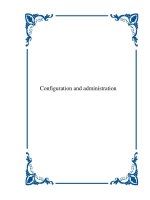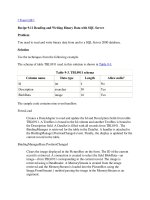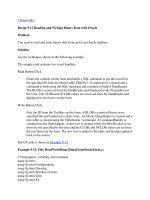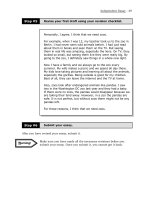Tài liệu Reading and Writing ppt
Bạn đang xem bản rút gọn của tài liệu. Xem và tải ngay bản đầy đủ của tài liệu tại đây (106.7 KB, 19 trang )
Denver Public Schools
Reading and Writing
page R–2
Introduction
The ability to communicate clearly—to read, write, speak, and listen—forms the core of
human culture. Reading, writing, speaking, and listening skills are essential tools for
learning, for success in the workplace, for enriching and expanding our lives, and for
responsible citizenship.
Language skills are particularly critical in the area of education. Through language
abilities, students understand the academic content areas. Success in learning
depends on students acquiring solid knowledge and skills in reading, writing, speak-
ing, and listening. As with the Colorado Model Content Standards, the proposed
Denver Public Schools standards set high expectations in these areas for all students.
Reading and writing have the power to bridge time and place. We remain in contact
with people who lived before us through literature and other written records of
human experience. We reach toward our future by knowing how to locate, read,
comprehend, and make use of an ever-increasing amount of information.
These standards express what each student in Denver should know and be able to
do in order to
• become fluent readers, writers, and speakers;
• communicate effectively, concisely, coherently, and imaginatively;
• recognize the power of language and use that power ethically and
creatively; and
• communicate with ease in an increasingly technological world.
Educators, parents, and communities can now focus their attention and energy on
creating the conditions under which all students can meet these expectations.
Therefore, it is the responsibility of the education community to intervene at the
earliest point in the student’s formal educational experience where, through careful
observation, it becomes apparent that a student is not progressing in a manner that
will lead to the meeting of these standards.
These standards will lead to the development of literate students who are proficient
in reading, writing, listening, speaking, creativity, problem solving, and researching
skills. Achievement of these standards gives students the ability to make meaningful
connections between life and educational experiences and enables them to enjoy
personal success. Given the importance of developing literate students, the reading
and writing standards cannot be accomplished in isolation. Literacy skills must be
developed in all content areas. Standards that incorporate the academic rigor in
these reading and writing standards will help students achieve standards for all
content areas and perform at expected levels of proficiency.
page R–3 Content Standards
Standards for Success
Developing Literacy
The primary goal of the Denver Public Schools is to
develop literate students. Students in the Denver
Public Schools will learn to read and will be
prepared to participate in society as literate
citizens, equipped with the ability to communicate
effectively in their communities, in the workplace,
and in postsecondary education. These reading
and writing standards set forth clear expectations
for student achievement in the areas of reading
and writing and are supported by the district
Elementary and Secondary Literacy Plans. The
literacy plans provide a framework which will
support the development of literate students. The
literacy plans include these strategies:
• providing effective reading instruction for all
students;
• providing professional development which
includes content and process strategies to
implement effective, necessary reading and
writing instruction for all students;
• supporting schools in acquiring appropriate and
quality materials for all students;
• monitoring the use of appropriate assessments
that measure student achievement in reading
and writing; and
• monitoring the implementation of content
standards for reading and writing instruction.
Reading and Writing Content Standards
1. Students read and understand a variety of
materials.
2. Students write and speak for a variety of
purposes and audiences.
3. Students write and speak using formal
grammar, usage, sentence structure,
punctuation, capitalization, and spelling.
4. Students apply thinking skills to their
reading, writing, speaking, listening, and
viewing.
5. Students read to locate, select, and make
use of relevant information from a variety of
media, reference, and technological sources.
6. Students read and recognize literature as a
record of human experience.
7. Students use appropriate technologies to
extend comprehension and communication
skills in reading, writing, speaking, listening
and viewing.
Denver Public Schools
Reading and Writing
page R–4
Note: A reference list of sources of book lists can be found at the end of the Reading and Writing Standards. None of these book lists has been endorsed by the Colorado State Board of Education.
In order to meet this standard, students will
1.1 use comprehension strategies such as using prior knowledge; previewing; predicting; inferring; comparing
and contrasting; rereading and self-monitoring; summarizing; identifying the author’s purpose, i.e., reason for
writing; determining the main idea; and applying knowledge of foreshadowing, metaphor, simile, symbolism,
and other identified figures of speech;
1.2 make connections between prior knowledge and what they need to know about a topic before
reading about it;
1.3 adjust reading strategies for a variety of purposes such as reading carefully, skimming and scanning,
fitting materials into an organizational pattern, reading a variety of literature chronologically, finding
information to support particular ideas, and finding the sequence of steps in publications including textbooks
and technical articles;
1.4 use word recognition skills, strategies, and resources such as phonics, context clues, picture clues, word
origins, and word order clues; reference guides; roots, prefixes, and suffixes of words for comprehension; and
1.5 use information from their reading to increase vocabulary and language usage.
Rationale. The goal for students at all levels is that they know and can use strategies—various ways of unlocking
the meaning of words and larger blocks of text—to become successful life-long readers. The strategies are applied in
increasingly difficult reading material at each grade level. At all levels, students should be challenged to read
literature and other materials that stimulate their interests and intellectual abilities. Reading from a wide variety of
texts, both assigned and student selected, provides experience in gaining information and pleasure from diverse
forms and perspectives.
STANDARD 1: Students read and understand a variety of materials.
GRADES K-4
In grades K-4, what the students know and are able
to do includes
• using a full range of strategies to comprehend
materials such as directions, nonfiction material,
poetry, plays, and stories.
page R–5
Content Standards
Standards for Success
Note: A reference list of sources of book lists can be found at the end of the Reading and Writing Standards. None of these book lists has been endorsed by the Colorado State Board of Education.
GRADES 5-8
As students in grades 5-8 extend their knowledge,
what they know and are able to do includes
• using a full range of strategies to comprehend
technical writing, newspapers, magazines,
poetry, short stories, plays, and novels in
addition to the types of reading material
mentioned in the K-4 benchmarks. Students
extend their thinking and understanding as they
read stories about people from diverse
backgrounds.
GRADES 9-12
As students in grades 9-12 extend their knowledge,
what they know and are able to do includes
• using a full range of strategies to comprehend
essays, speeches, biographies, autobiographies,
and first person historical documents in addition
to the types of literature mentioned in previous
grade level benchmarks.
STANDARD 1: Students read and understand a variety of materials.
Denver Public Schools
Reading and Writing
page R–6
Note: A reference list of sources of book lists can be found at the end of the Reading and Writing Standards. None of these book lists has been endorsed by the Colorado State Board of Education.
In order to meet this standard, students will
2.1 expand vocabulary development using a variety of methods such as synonyms, antonyms, metaphors,
similes;
2.2 write and speak for a variety of purposes such as telling stories, presenting analytical responses to
literature, conveying technical information, explaining concepts and procedures, and persuading;
2.3 write and speak to peers, teachers, and the community;
2.4 plan, draft, revise, proofread, edit, and publish written communications;
2.5 use a variety of literary devices such as figurative language, symbolism, dialect, and precise
vocabulary to convey meaning;
2.6 prepare written and oral presentations using strategies such as lists, outlining, cause/effect relationships,
comparison/contrast, problem/solution, and narration; and
2.7 use the most appropriate method, handwriting or word processing, to produce a product that is
legible.
Rationale. Writing and speaking are essential tools for learning, for success in the workplace, and for responsible
citizenship. Developing a range of writing and speaking abilities requires extensive study, practice, and thinking.
Students need frequent opportunities to write and speak for different audiences and purposes, and they need to be
able to communicate creatively, expressively, informatively, and analytically. Growth in writing and speaking abilities
occurs by applying skills to increasingly challenging communication tasks.
STANDARD 2: Students write and speak for a variety of purposes and audiences.
GRADES K-4
In grades K-4, what students know and are able to
do includes
• generating topics and developing ideas for a
variety of writing and speaking purposes (for
example, telling a sequential story, publishing a
class newsletter, writing a letter to an adult,
writing or orally presenting a book report,
creating and producing a play, introducing a
speaker or an event, narrating a presentation,
researching, writing, and presenting a report);
• organizing their speaking and writing;
• choosing vocabulary that communicates their
messages clearly and precisely;
• revising and editing speech and writing;
• editing the written work of others; and
• creating readable documents with legible
handwriting or word processing as
developmentally appropriate.
page R–7
Content Standards
Standards for Success
Note: A reference list of sources of book lists can be found at the end of the Reading and Writing Standards. None of these book lists has been endorsed by the Colorado State Board of Education.
GRADES 5-8
As students in grades 5-8 extend their knowledge,
what they know and are able to do includes
• telling and writing stories, reports, and letters
with greater detail and supporting material;
• choosing vocabulary and figures of speech that
communicate clearly in writing and speaking;
• drafting, revising, editing, and proofreading for a
legible final copy;
• critiquing and editing the written work of others;
• applying skills in explanation, analysis, synthesis,
and evaluation in their writing and speaking;
• incorporating source materials into their
speaking and writing (for example, interviews,
news articles, encyclopedia information);
• writing and speaking in the content areas, using
the technical vocabulary of the subject
accurately; and
• recognizing and using stylistic elements such as
voice, tone, and style in reading, writing, and
speaking.
GRADES 9-12
As students in grades 9-12 extend their knowledge,
what they know and are able to do includes
• creating and presenting complex written and
spoken works;
• using fictional, dramatic, and poetic techniques in
writing;
• conveying technical information in a written and
spoken form appropriate to the audience;
• supporting an opinion using various forms of
persuasion (factual or emotional) in speaking and
writing;
• incorporating material from a wider range of
sources (for example, newspapers, magazines,
interviews, technical publications, books) in their
writing and speaking;
• selecting a focused topic and drafting, revising,
editing, and proofreading a legible final copy;
• writing and speaking for various audiences in
specialized fields such as career and academic
interest areas (for example, scientific, technical,
business, and electronic communication video);
and
• experimenting with stylistic elements such as
voice, tone, style, and audience in writing.
STANDARD 2: Students write and speak for a variety of purposes and audiences.
Denver Public Schools
Reading and Writing
page R–8
Note: A reference list of sources of book lists can be found at the end of the Reading and Writing Standards. None of these book lists has been endorsed by the Colorado State Board of Education.
In order to meet this standard, students will
3.1 recognize, understand, and use formal grammar in speaking and writing;
3.2 apply formal usage in speaking and writing;
3.3 use correct sentence structure in writing;
3.4 demonstrate correct punctuation, capitalization, and spelling; and
3.5 recognize and know when it is appropriate to use dialectical, idiomatic, and colloquial language,
including awareness and appreciation of cultural and dialectic variance.
Rationale. Recognition, understanding, and use of formal English is essential to effective communication. Students
recognize, understand, and use formal English. Proficiency in this standard plays an important role in how the writer
or speaker is understood and perceived. All skills in this standard are reinforced and practiced at all grade levels
and should be monitored by the teacher, student, and parents to develop lifelong learning skills.
GRADES K-4
In grades K-4, what the students know and are able
to do includes
• recognizing, understanding, and using subject-
verb agreement;
• recognizing, understanding, and using correct
modifiers;
• recognizing, understanding, and using correct
capitalization, punctuation, and abbreviations;
• spelling frequently used words correctly using
phonics rules and exceptions; and
• using spoken and written language situationally.
STANDARD 3: Students write and speak using formal grammar, usage, sentence structure, punctuation, capitalization, and
spelling.









